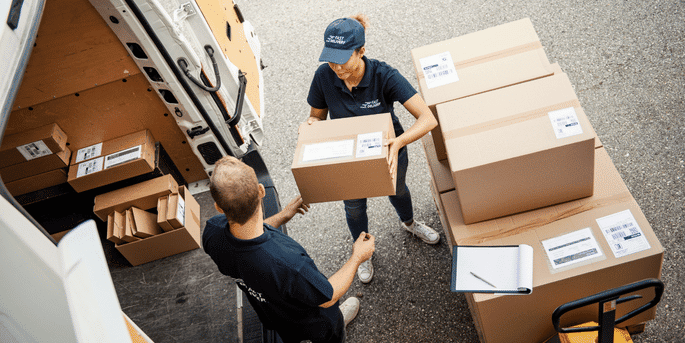Key takeaways
For businesses trying to streamline their processes and cut costs, reverse logistics is an essential but sometimes disregarded part of supply chain management. Through comprehending and executing efficient reverse logistics tactics, companies can not only recover diminished value from returned merchandise but also enhance their profitability and sustainability as a company model. Using cutting edge technologies, such automation and sophisticated tracking systems, may transform how businesses manage product returns and optimize their processes. In addition, overcoming regulatory obstacles and working with stakeholders are essential elements of successfully implementing sustainable practices in reverse logistics. Through the use of data-driven initiatives and a focus on sustainability, businesses can fully realize the promise of reverse logistics and create an eco-friendly and more efficient supply chain. supply chain.

Introduction
A crucial component of supply chain management that is sometimes disregarded but has enormous promise for companies trying to improve their sustainability initiatives is reverse logistics. Businesses can lessen their environmental impact, promote a more circular economy, and recover lost value from returned goods by comprehending and putting into practice efficient reverse logistics techniques. Companies now have the tools to optimize their reverse logistics processes, lower costs, and increase customer satisfaction thanks to technological and data analytics improvements. Companies may overcome the difficulties and complexities associated with sustainable reverse logistics processes by working together, being innovative, and having a common commitment to sustainability. Adopting reverse logistics is a step toward a more sustainable future for businesses as well as a wise business decision. all stakeholders involved.
Understanding the concept of reverse logistics
An essential component of supply chain management is reverse logistics, which is the effective and sustainable handling of goods as they are transported back to their point of origin from their final destination. This procedure includes a number of tasks, such as handling product returns, assisting with repairs, encouraging recycling programs, and making sure that the right disposal techniques are used. Businesses can recover value from goods that consumers no longer need or want by managing reverse logistics well, which eventually helps to create a more economical and sustainable company model.
By comprehending the idea of reverse logistics, businesses may take advantage of a significant chance to reduce waste and support a more sustainable business model, in addition to recovering lost value from products that customers no longer need. In addition to improving the bottom line of the business, this strategic strategy supports the company’s more significant environmental and social responsibility objectives. Reverse logistics makes it possible to reassess and repurpose products, fostering a circular economy that lessens the burden on resources and the negative environmental effects of having extra or undesired commodities. In summary, adopting reverse logistics is a commitment to a more sustainable future for all parties involved, not merely a wise financial decision.
Businesses may create creative solutions to improve customer happiness and environmental sustainability while simultaneously cutting costs and managing product returns more effectively by grasping the idea of reverse logistics. Businesses can enhance their reverse logistics operations and create a more streamlined and effective process by examining data pertaining to product returns in order to spot patterns and trends. By using a data-driven strategy, businesses can address the root causes of product returns, which lowers return rates and raises consumer satisfaction levels overall. Additionally, businesses can improve their tactics to reduce waste, recover value from returned goods, and contribute to society by utilizing technical breakthroughs in reverse logistics management, such as sophisticated tracking systems and automation technologies. to a more sustainable business model. Through a holistic approach that combines data analytics, technological innovation, and strategic partnerships, companies can unlock the full potential of reverse logistics and create a more sustainable future for all stakeholders involved.
Challenges of implementing sustainable practices in reverse logistics
Manufacturers, retailers, and logistics providers are just a few of the stakeholders that must effectively collaborate and coordinate in order to implement sustainable practices in reverse logistics. Every stakeholder is essential to making sure that items are handled and processed in an efficient and ecologically responsible way. Retailers must encourage sustainable purchasing habits and make it easier for customers to return merchandise, while manufacturers must consider how best to design their items for recycling and reuse. In order to minimize waste and enhance value recovery, logistics providers are essential to the processing and shipping of returned items.
The recycling or disposal of specific products may also be complicated by legal and regulatory issues, which presents another level of difficulty for the sustainable management of reverse logistics. While navigating these rules and ensuring compliance, businesses must continue to work toward their sustainability objectives. To overcome these obstacles, creative thinking, solid alliances, and a shared dedication to sustainability along the whole supply chain are needed. Stakeholders can solve these issues and develop a more sustainable reverse logistics system that boosts the economy and the environment by cooperating and utilizing one another’s skills.
Reverse logistics management is made much more difficult by the intricate legal and regulatory regulations that surround the recycling or disposal of specific products. Businesses must work around these rules while pursuing their sustainability objectives, which frequently call for creative solutions and a dedication to sustainability along the whole supply chain. Stakeholders must collaborate to come up with innovative solutions to these problems, whether that means putting new technologies into use, establishing strategic alliances, or pushing for legislative changes that encourage environmentally friendly reverse logistics practices. Companies may clear the path for a more effective and ecologically responsible reverse logistics system that benefits the environment and the business by tackling these challenges with a shared drive to sustainability.
Technological advancements in reverse logistics management
Innovations in technology have completely changed how businesses handle reverse logistics. Companies can now precisely watch the transit of returned goods in real-time thanks to the installation of sophisticated tracking and tracing technologies. In addition to facilitating precise tracking, this degree of insight helps businesses pinpoint areas where their reverse logistics procedures need to be improved. Businesses can improve overall efficiency and customer happiness by identifying inefficiencies, streamlining procedures, and optimizing routes by utilizing these solutions.
Automation technologies like robotic sorting systems, in addition to tracking systems, have greatly increased the efficiency and precision of processing returned goods. The time and labor needed for manual handling can be decreased by using these automated solutions, which can sort and process goods efficiently. Through the use of automation into their reverse logistics operations, companies can increase productivity, reduce costs, and ensure a more seamless and efficient process from start to finish.
Additionally, machine learning techniques and data analytics are now widely used in reverse logistics process optimization. Through the examination of extensive data pertaining to product returns, businesses can acquire significant understanding of consumer behavior, product efficacy, and operational efficiency. With the help of this data-driven strategy, businesses may spot trends, make well-informed decisions, and take proactive measures to resolve problems before they become costly. Businesses may boost decision-making, optimize reverse logistics processes, and eventually increase supply chain management’s sustainability and profitability by utilizing data analytics.
Furthermore, the way businesses manage reverse logistics operations has been completely transformed by automation technologies. For example, robotic sorting systems can effectively classify and handle returned goods, greatly enhancing the process’s speed and accuracy. Businesses can decrease the time and manpower needed for manual handling by automating these processes, which will ultimately increase productivity and save operating costs. The smooth use of automation technology guarantees a more effective and efficient reverse logistics process, which improves customer satisfaction in addition to streamlining operations.
Moreover, the integration of data analytics and machine learning algorithms further optimizes reverse logistics processes. By analyzing vast amounts of data related to product returns, companies can gain valuable insights into customer behavior, product performance, and operational efficiency. This data-driven approach empowers companies to make informed decisions, identify trends, and proactively address issues that may lead to returns. By harnessing the power of data analytics, companies can continuously refine their reverse logistics operations, enhance decision-making, and drive greater sustainability and profitability in their supply chain management. The synergy of automation technologies and data analytics not only improves operational efficiency but also contributes to a more sustainable and cost-effective business model.

Importance of data analytics in optimizing reverse logistics processes
Data analytics is the backbone of successful reverse logistics processes, providing companies with valuable insights and opportunities for optimization. By delving into the data surrounding product returns, companies can uncover patterns and trends that offer a deeper understanding of their reverse logistics operations. This analysis not only identifies the root causes of returns but also enables companies to address underlying issues, ultimately reducing return rates and enhancing overall customer satisfaction.
One of the key benefits of data analytics in reverse logistics is its ability to forecast product returns. By utilizing predictive analytics, companies can anticipate return volumes, allowing them to allocate resources effectively, streamline operations, and proactively plan for any potential challenges. This forward-thinking approach not only improves operational efficiency but also minimizes disruptions and maximizes the value recovery from returned products.
Moreover, data analytics empowers companies to make informed, data-driven decisions at every stage of the reverse logistics process. By leveraging data insights, companies can continuously refine their operations, identify opportunities for improvement, and drive greater sustainability and profitability within their supply chain management. With data analytics as a guiding force, companies can navigate the complexities of reverse logistics with precision and agility, paving the way for a more efficient, cost-effective, and sustainable business model.
Collaboration and partnerships in achieving sustainable reverse logistics
In addition to collaborating with retailers on take-back programs, manufacturers can also work closely with suppliers to source sustainable materials and design products with longevity and recyclability in mind. By incorporating eco-friendly practices into the production process, manufacturers can reduce the environmental impact of their products and facilitate the recycling or repurposing of materials at the end of their lifecycle.
Furthermore, logistics providers can forge partnerships with third-party logistics companies that specialize in sustainable transportation and packaging solutions. By optimizing transportation routes, utilizing green packaging materials, and implementing energy-efficient practices, logistics providers can minimize carbon emissions and reduce the overall environmental footprint of reverse logistics operations.
Government agencies play a crucial role in supporting sustainable reverse logistics practices by enacting policies that promote circular economy principles and incentivize businesses to adopt environmentally friendly practices. By offering tax incentives for companies that implement recycling programs or providing grants for research and development of sustainable technologies, governments can encourage the adoption of sustainable practices and drive positive change within the industry.
Ultimately, by fostering collaboration and partnerships among manufacturers, retailers, logistics providers, and government agencies, stakeholders can work together to create a more sustainable and efficient reverse logistics system. Through shared commitment and innovative solutions, the industry can move towards a circular economy model that prioritizes environmental stewardship and economic prosperity. By working hand in hand, stakeholders can pave the way for a greener future and a more sustainable supply chain that benefits both businesses and the planet.
Conclusion
In conclusion, technological advancements, data analytics, and collaboration are key drivers of success in the realm of sustainable reverse logistics. By leveraging advanced tracking systems, automation technologies, and data analytics, companies can streamline operations, increase efficiency, and drive greater sustainability and profitability in their supply chain management. Additionally, collaboration among manufacturers, retailers, logistics providers, and government agencies is essential in creating a more sustainable and efficient reverse logistics system. By working together, stakeholders can pave the way for a greener future and a more sustainable supply chain that benefits both businesses and the planet. It is through shared dedication, innovative solutions, and a commitment to sustainability that the industry can move towards a circular economy model that prioritizes environmental stewardship and economic prosperity.
FAQ
What are the challenges of reverse logistics
Challenges in reverse logistics are varied and complex, requiring careful consideration and innovative solutions to overcome. One of the main challenges is the lack of visibility and control over the return process, leading to inefficiencies and increased costs. Without advanced tracking systems and automation technologies, companies may struggle to accurately monitor returned products and identify areas for improvement. Additionally, the manual handling of returns can be time-consuming and labor-intensive, resulting in delays and errors in processing.
Another challenge in reverse logistics is the high cost associated with product returns, including transportation, restocking, and disposal expenses. Companies must carefully manage these costs while maintaining customer satisfaction and sustainability goals. Furthermore, the complexity of managing returns across multiple channels and locations can lead to logistical challenges and coordination issues.
In order to address these challenges, data analytics is essential because it gives businesses the insights they need to optimize processes and cut costs. By examining trends and patterns in return data, businesses can make more informed decisions and increase operational efficiency. Partnerships and collaboration are also important because they enable stakeholders to work together to implement sustainable practices and promote positive change in the reverse logistics sector.
Which of the following is a difficulty in reverse logistics?
Effectively handling the large number of returned goods is one of the biggest challenges in reverse logistics. Businesses need to properly handle, categorize, and resupply items amidst the deluge of returns from diverse channels and locations. In the absence of an efficient system, managing returns by hand may result in inaccuracies, delays, and higher running expenses. This lack of visibility and control over the return process can make it more difficult for businesses to meet sustainability targets and optimize their reverse logistics operations. Utilizing automation technology, data analytics, and sophisticated tracking systems, businesses can surmount this obstacle and improve the effectiveness of their reverse logistics procedures.
What are the barriers to reverse logistics?
Reverse logistics obstacles can take many different forms, impeding the smooth operation of the process and lowering its overall efficiency. The absence of defined procedures and stakeholder communication, which causes misunderstandings, hold-ups, and inefficiencies, is one of the main obstacles. Companies could find it difficult to manage returns and communicate with partners, suppliers, and transportation providers if they don’t have clear policies and procedures in place.
The unwillingness or aversion to adopt new technologies and alter customary habits is another important obstacle. Apprehensive about the upfront expenses or potential interruptions to their current operations, some businesses could be reluctant to invest in automation solutions, data analytics tools, or sustainable practices. To overcome this obstacle and promote long-term sustainability, a mentality change toward embracing digital transformation benefits and competitive advantages.
Additionally, regulatory constraints and compliance requirements can pose challenges in reverse logistics, particularly when dealing with hazardous materials, recycling regulations, or cross-border returns. Companies must navigate a complex landscape of laws and regulations, ensuring that they meet environmental standards, consumer protection laws, and sustainability targets while managing returns effectively.
Addressing these barriers requires a strategic approach, leveraging technology, data analytics, and collaboration to optimize reverse logistics processes and drive sustainable practices. By overcoming these challenges, companies can unlock new opportunities for efficiency, cost savings, and customer satisfaction in their reverse logistics operations.
What are the factors affecting reverse logistics?
Factors affecting reverse logistics can vary based on the industry, company size, and specific operational challenges. Some common factors include the volume and type of returned products, the complexity of the supply chain network, the level of automation and technology integration, and the availability of data analytics tools.
The volume and type of returned products play a crucial role in determining the efficiency of reverse logistics operations. High volumes of returns can overwhelm manual processing systems and lead to delays and errors, while the diversity of product types can require specialized handling and disposal methods.
The complexity of the supply chain network, including the number of partners, suppliers, and distribution channels involved, can also impact the effectiveness of reverse logistics. Coordination and communication among stakeholders are essential to ensure seamless operations and minimize disruptions.
The level of automation and technology integration in reverse logistics processes can streamline operations, improve accuracy, and reduce costs. Advanced tracking systems, automated sorting processes, and data analytics tools can provide valuable insights and optimize decision-making throughout the reverse logistics process.
Lastly, the availability of data analytics tools is crucial in identifying trends, patterns, and opportunities for improvement in reverse logistics. By leveraging data insights, companies can make informed decisions, optimize processes, and drive greater sustainability and profitability within their supply chain management.
Hope this article was helpful for more check out previous blog post by clicking here

